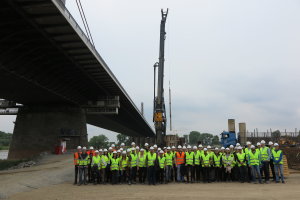
At the end of the lecture period, the master students of geotechnical engineering first went to the construction site of the new Rhine bridge in Leverkusen. In an overview lecture, the client Straßen.NRW first gave an impressive presentation on the history of the current Rhine bridge in Leverkusen and the results of the analysis of the current structural condition of this bridge and thus the necessity of the new construction. The overall concept of the future traffic routing and the construction measures necessary in addition to the new bridge construction were then presented. A short presentation of variant investigations as well as the structural challenges, e.g. in the area of the old Dhünnaue landfill, rounded off the overview. Afterwards, the site managers of Stump-Franki Spezialtiefbau GmbH led the students in two groups across the bridge which is still in operation. They explained the foundation measures and showed detailed solutions on the pier foundations, which are in different stages of construction. In the second part, the area development project MARK 51°7, the revitalization of the former Opel site in Bochum, was visited. Bochum Perspektive 2022 GmbH welcomed the group in the historic factory building with refreshments and presented the boundary conditions and objectives of the project. The Heitkamp group of companies provided detailed information on the exploration, deconstruction and earthworks and then led a tour of the site. Thanks to the support of the chair's Friends Association, the excursion day ended with a relaxed barbecue evening at the Chair's experimental halls. Thanks are due to the organising companies, Stump-Franki Spezialtiefbau GmbH and Heitkamp Unternehmensgruppe, the supporting contractors, Straßen.NRW and Bochum Perspektive 2022 GmbH, as well as HUESKER Synthetic GmbH for the enjoyable lunch.
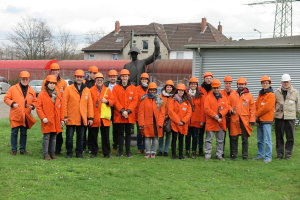
The aim of the excursion, which Prof. Bröker offered as part of the course "Überwachung der Emissionen genehmigungsbedürftiger Anlagen - rechtlicher Rahmen und ausgewählte Beispiele", was Hüttenwerke Krupp Mannesmann GmbH (HKM) in Duisburg. After an introductory presentation as well as detailed explanations on how to deal with emissions, Mr. Dipl.-Ing. Dieter Kretschmer led a tour through the plant premises for more than 2 hours , from the port to coal preparation, the coking plant and the blast furnaces to the steelworks. In addition to vivid explanations of the production processes, he used many technical details to illustrate how much development work and innovation is required to make such a plant globally competitive and to keep it up to date with regard to emissions and thus eligible for approval. We would like to thank Mr. Kretschmer and HKM for their leadership and our long-time lecturer Prof. Bröker for the organisation.
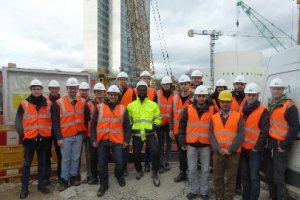
On 23.11.2017 the Master students of the specialisation Geotechnical Engineering and Tunnelling visited the construction site Kö-Bogen II in Düsseldorf. Mr. Dipl.-Ing. Voßnacke from Bauer Spezialtiefbau GmbH welcomed the group, introduced them to the construction project with a presentation and explained the individual trades of foundation engineering, their challenges and the boundary conditions under which the work is to be carried out. Afterwards the construction site was visited in two groups and the individual machines were observed in operation. Among other things, the production of barrettes with the diaphragm wall excavator with hydraulic grab and the production of large bored piles under suspension support in different phases as well as the preparation of the primary supports for the installation in barrettes and bored piles could be seen. In addition, the production of slurry and its preparation was illustrated. Many thanks to Mr. Voßnacke and the company Bauer Spezialtiefbau for the organisation and support.
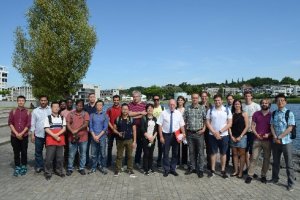
On Tuesday, July 18, 2017, the annual excursion of the Chair of Foundation Engineering, Soil and Rock Mechanics took place. This year's destination was the city of Dortmund, formerly world-famous for its mining and brewing industry. The explicit aim of this day was to personally experience the two catchwords that characterize the Ruhr area of the 21st century, industrial culture and structural change. How the former industrial moloch of the Phoenixhütte could be turned into a local recreation area including yacht harbour and vineyard, unique in Europe, was explained to us by members of the chair and our guests Mr. Göceri from TABERG Ingenieure GmbH and Mr. Hueppe from the former PHOENIX See Entwicklungsgesellschaft. No less impressive was the transformation of the building of the former Union Brewery into one of the beacons of the cultural metropolis Ruhr, the Dortmunder U. There, under the guidance of the staff of the Hartware MedienKunstVerein, the current exhibition, which deals with the architectural style of Brutalism, was visited. Especially for us members of the Ruhr-University this is a topic that offers a lot of discussion material every day. In particular, not approaching the building as engineers for one day, but rather questioning socio-cultural aspects, opened up completely new perspectives on this architectural style, which is treated rather disrespectfully nowadays. The day ended with a visit to one of the last production sites of the above-mentioned industrial sectors. Thanks to the vivid guided tour, the group again gained many new insights into this art, which had almost disappeared in Dortmund, but which continues to create identity.
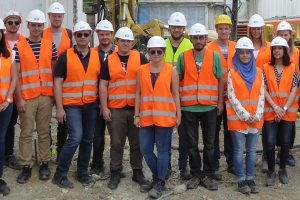
Vibratory compaction, micropiles and bored pile wall were the main works to be observed during the excursion of the master students in the field of geotechnics. With the support of the Friend's Associations 15 students and 5 members of the Chair's staff had made their way to three construction sites in the area of Dortmund and Herne on 6.7.2017 to experience special foundation engineering on site. Many thanks to the contractors, Keller Grundbau GmbH, Stump Spezialtiefbau GmbH and Bauer Spezialtiefbau GmbH, who made the site visits possible and whose employees provided detailed information about the construction measures and the individual work steps.
In the context of a historical and cultural further education on the topic "Scientific progress of the Ruhr area in modern times", the Chair of Foundation Engineering, Soil and Rock Mechanics decided to explore the Duisburg area this year. The journey through time began on June 7th with a visit to the Mercator treasure chamber in the Kultur- und Stadthistorisches Museum Duisburg. Here the group was explained the great importance of the geographer and cartographer Gerhard Mercator, who made a decisive contribution to the development of regional maps as well as world maps. Mercator's projection, which he developed to facilitate navigation at sea by providing a true angle image of the earth's surface, is still used today in most two-dimensional representations of the earth. The second station was a round trip through Duisburg's inner port, which is considered the largest inland port in Europe. Of special interest for the chair was, besides the production and transhipment sites for goods of all kinds, the geotechnical execution of the quays, especially the rehabilitation of quay walls and the anchoring of sheet piles. At the end of the day, the group went to the Landschaftspark Duisburg Nord to inspect the former industrial site more closely and learn more about blast furnace technology. At the same time, the visit clearly showed how the structural transformation of the Ruhr area is progressing and what opportunities are available for the revaluation of brownfield sites. By integrating individual buildings into the new landscape concept, the economic and cultural significance for the region could be preserved. Since the topics of brownfield recycling, remediation of contaminated sites and soil management are also the focus of current research projects at the Department of Foundation Engineering, Soil and Rock Mechanics, the visit to the landscape park offered many starting points for exciting discussions.
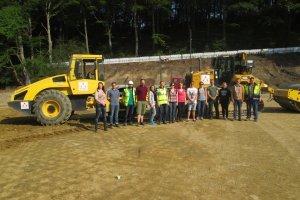
In the context of the lecture "Earthworks" an excursion took place again this year. On 13.5. about ten students of civil engineering, UTRM and geology visited a construction site at the Hiddinghauser Straße in Gevelsberg. The site management explained on site which work steps are necessary to prepare the area of 4.000 m² for the construction of a refugee accommodation. For this purpose, over 10,000 m³ of soil will be installed and compacted in layers. The students were able to see very clearly how the work steps are carried out with construction machinery. Afterwards there was a snack and the possibility to ask questions to the responsible persons and to exchange professional experiences. We would like to thank Dr. Stoffers and the Heitkamp company for the organization and realization of this excursion.
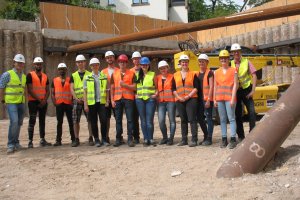
Master students specialising in tunnelling and geotechnical engineering visited the "Konrad-Adenauer-Ufer" excavation pit of KAU Projekt GmbH in Cologne on Friday, June 26, 2015. Site manager Timo Föhrer (BSc) from the construction company BAUER Spezialtiefbau GmbH guided the group through the inner-city excavation pit, where an office building is to be constructed which will directly adjoin the existing buildings. A large number of the processes discussed in the lectures were on display in their execution:: Trägerbohlwand, bored pile wall, sheet pile wall, Gewi piles, injection anchors, struts, high pressure injection and underwater concrete floor. Mr. Föhrer explained in detail the boundary conditions from the ground conditions, surrounding buildings, spatial restrictions and requirements for the structure to be built, which led to the use of the different techniques. Furthermore, he showed numerous examples of how flexibly planning and execution must react to previously unknown boundary conditions, e.g. due to unexpected old stock, in order to be able to keep to the schedule. It was a successful excursion that complemented the courses, for which the students and teachers would like to thank Mr. Föhrer and the company Bauer Spezialtiefbau as well as the client.
On February 10, 2015, 11 employees of the chair took the opportunity to go underground in the Auguste-Viktoria mine. After an introduction to the topic of hard coal mining in the Ruhr area and the fitting of mining clothes in the dressing rooms we first went down the shaft of the operating area 8 to level 6 (about 1100 m depth). After about half an hour's drive on foot and with the diesel trolley through the roadway we reached the longwall mining area. There we could watch the coal being extracted by means of a shearer while the mine was still in operation. After nearly three hours underground we were served a hearty meal during the final exchange of ideas. We would like to thank Mr. Stellmacher of the RAG for the informative and committed guided tour!